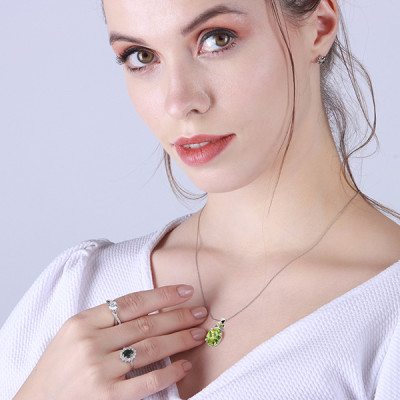TOPAZ GUIDE
(NOVEMBER BIRTHSTONE)
Topaz is a precious stone that comes from a rare silicate material. It is known to occur in a range of countries, including Brazil, Madagascar and the United States. Topaz is used in all types of jewellery, including rings, pendant necklaces and earrings. This is because it is durable, affordable and available in a vast array of colours.
November’s Birthstone
One of the reasons for the popularity of topaz is that it is November’s original birthstone. It is the gemstone associated with the Scorpio Zodiac sign. A topaz stone is an emblem for love and affection. Wearing it in a piece of jewellery is meant to bestow increased intellect and strength upon the wearer.
Hard And Durable
Topaz rates at number 8 on the Mohs Hardness Scale. The scale indicates how durable a stone is and what can potentially damage it. This means that topaz cannot be scratched or damaged by other gemstones that rate at 7 or below. Topaz is actually one of the hardest naturally occurring minerals and incredibly durable.
The Worth Of Topaz
While the overall price of a piece of jewellery will depend on the cut, setting and metal used, topaz is an affordable option for most buyers. Topaz can be naturally colourless, allowing jewellers to treat it with heat or radiation to transform the colour. Most blue topaz on the market is produced in this way, and can usually be bought for as little as £20 a carat.
What Colour Is Topaz Stone?
Topaz is a versatile stone that can take on a selection of colours. These are created either by naturally occurring impurities or by treatment with radiation or heat. You can find natural topaz in shades of red, orange, yellow, pink, purple and blue. Topaz is most commonly found without any colour, and this is the cheapest option.
The Rise Of Blue Topaz
Most blue topaz in jewellery comes from colourless topaz. Once treated, it takes on its gorgeous blue hue, and is available for a fraction of the cost of a naturally occurring blue topaz stone. This is why blue topaz is so reasonably priced. As it can be created, there is a lot more of it around than some of topaz’s naturally occurring colours.
The most valuable topaz stone is known as Imperial Topaz. It has an almost golden appearance with deep red undertones and an orange or yellow glow. Most topaz stones are free of flaws, making the Imperial Topaz a dazzling addition to your jewellery collection.
Birthstone Colours
As November’s birthstone, a warm yellow topaz stone is the standard colour. It projects positivity, whereas the alternative blue option is a calming influence. Any colour of topaz can be used to represent November, but most commonly people will opt for a traditional yellow or blue.
If you are buying for a loved one, take into consideration their personality and how they like to express themselves. Someone with traditional style will want a yellow or blue topaz to signify November. However, someone who is more quirky might prefer a rarer colour to differentiate themselves.
How To Clean A Topaz Ring?
Topaz is durable, but not infallible. It is important to take great care when cleaning a topaz ring in order to preserve its colour and brilliance.
To clean a topaz ring, you only need a bowl of warm water mixed with a small amount of mild soap. Anything with harsh chemicals should be avoided. You can soak the ring in this solution for around half an hour.
Once it has been soaked, you can take the ring out and clean it with either a micro fibre cloth or a soft toothbrush. Always remember to clean the underside of a ring, as this is where most grime will build up as you wear it. Pat the ring dry before storing or wearing it again.
Cleaning Treated Blue Topaz
White topaz is often treated to take on a blue colour. If you are cleaning treated topaz, it is important to use light touches and not rub the stone with too much force. Doing so can cause the colour to fade.
The best advice for maintaining the colour of your topaz stone is to avoid exposing it to bright light or heat for a long period of time. This will cause the colour to fade. Also avoid hitting a surface with force while wearing the ring, as a sharp blow to the stone can shatter it in some cases.
Faq
The price of topaz jewellery will depend on the number of carats, setting, cut and metal used. Our collection of topaz jewellery starts at £120 and can go upwards of £3000.
In terms of price per carat, each jeweller will vary slightly in their valuation. As a general rule of thumb a treated blue topaz costs £20 per carat. This is often the cheapest option because blue topaz is made in abundance. Colourless topaz can sell for £80 a carat, which is still a relatively inexpensive option.
For rarer topaz stones, prices rise considerably. Imperial Topaz can sell for up to £1000 per carat. Equally, stones with naturally occurring pink or red tones can sell for £3500 a carat.
Citrine and topaz are commonly confused, but they are from completely different mineral families. Citrine is a type of quartz stone.
They are often mixed up because while topaz is the original birthstone for November, the alternative is a yellow citrine stone.
White topaz can become cloudy over time. If the clarity of the stone is poor, it will adopt a cloudy and opaque appearance. It is important to be delicate with white topaz because scratches will also affect the clarity of the stone. With enough scratches, white topaz looks cloudy and faded.
There are small but significant differences between blue topaz and aquamarine. Most noticeable is that blue topaz will usually have light blue hues, whereas aquamarine will be blue, but also have hints of green.
Aquamarine is less refractive than topaz, making it seem less shiny and duller than a topaz stone. Topaz weighs more than aquamarine, so you should feel the difference in a piece of jewellery when you wear it.
Want to learn more about birthstone meanings? Check out our birthstone guides by month:
Browse All 12 Birthstone Guides
-

Garnet
January Birthstone -

Amethyst
February Birthstone -

Aquamarine
March Birthstone -

Diamond
April Birthstone -

Emerald
May Birthstone -

Pearl
June Birthstone -

Ruby
July Birthstone -

Peridot
August Birthstone -

Sapphire
September Birthstone -

Opal
October Birthstone -

Topaz
November Birthstone -

Tanzanite
December Birthstone

Article written by Nilesh
 Trustpilot
Trustpilot



